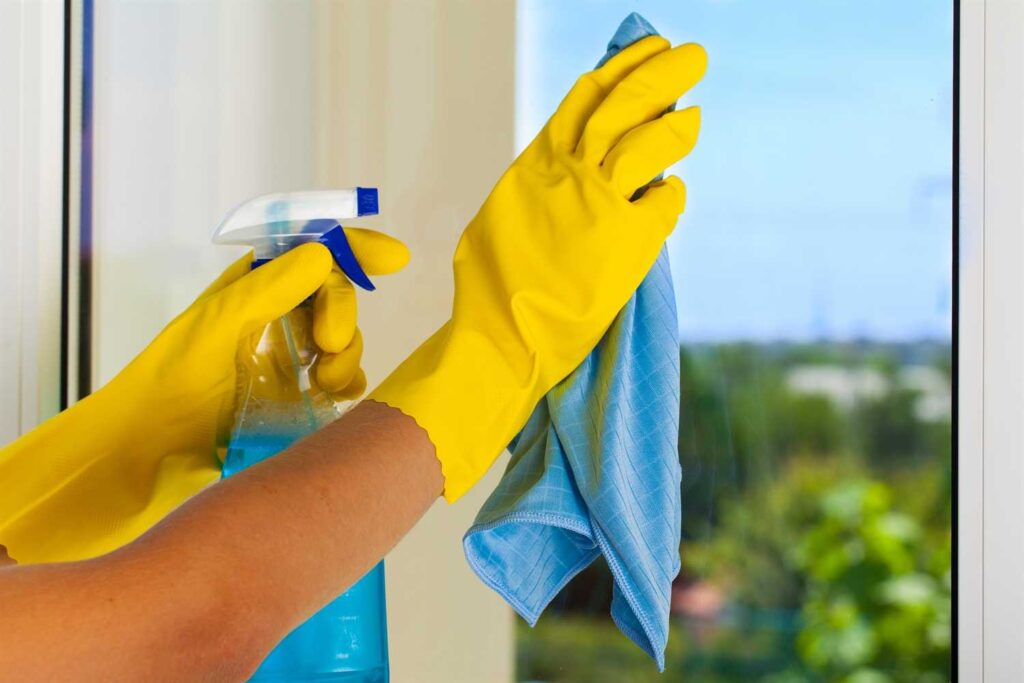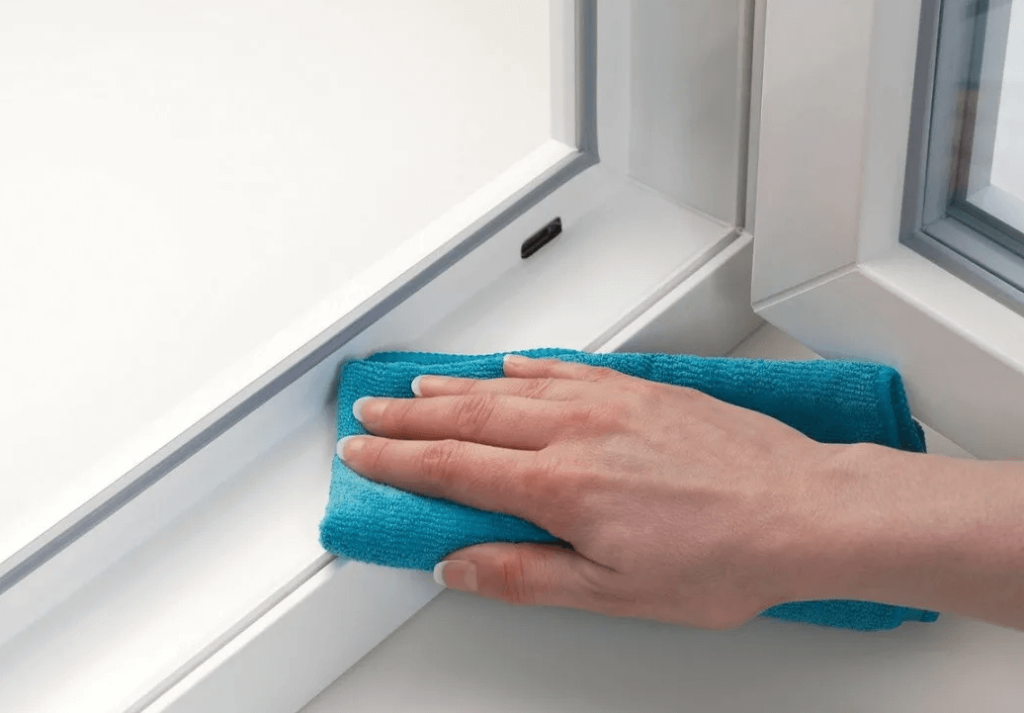For those who are about to wash windows, we have prepared a step-by-step guide, tips, and life hacks for achieving perfectly clean glass.
- Main rules
- How to wash windows without streaks
- What to use for washing
- How to wash outside
- How to clean plastic windows
Main Rules
Dirty windows both on the outside and inside can spoil the impression of a house, no matter how clean and beautiful it may be. Streaks may remain from dust and rain, from using a sprayer when watering plants; fingerprints, condensation, and traces of insects may be left on the glass. Washing windows is sufficient a couple of times a year, ideally once in spring-summer and once in autumn. The exception is ground floor rooms, where there is more dirt and cleaning may be required more frequently. It’s best to wash windows when it’s dry outside, there’s no wind, it’s warm but not hot. Washing windows in below-zero temperatures is pointless, and bright sunlight and wind quickly dry the water on the glass, causing streaks.
Window Washing Algorithm
1. Prepare cleaning agents, cloths, sponges, a mop.
2. Remove curtains and clear all items from the windowsill.
3. Clean the blinds (you can remove them and wash them with a brush in the bathroom).
4. Thoroughly wash the window frame on both sides.
5. Wash the glass first on the outside, then on the inside.
6. If necessary, remove residual moisture with a dry cloth or newspaper.
How to Wash Windows Without Streaks

Much depends on the chosen products and tools. Prepare several cloths in advance—for applying the solution, rinsing it with water, and wiping the glass dry. Microfiber cloths are available for sale, but many prefer to use a regular newspaper for the final part of cleaning. You will also need a bucket, sponges (regular dish sponges will do), protective gloves, a rubber scraper for stubborn dirt, and a mop for hard-to-reach places.
Windows should be washed from top to bottom to avoid spreading dirt on clean glass. First, use a cloth with the chosen cleaning agent to remove dust, then use a scraper to remove dried-on dirt. Avoid using iron scouring pads and stiff brushes—they can damage the glass.
What to Use for Window Cleaning
In addition to commercially available cleaning products, there are tried-and-tested homemade solutions. They are usually cheaper but may not always meet quality requirements.
Rubbing Alcohol Solution
It’s easy to make a cleaning solution with rubbing alcohol. Recipe: for 3 liters of water, add 3-4 ml of rubbing alcohol. Sometimes a little glycerin is added to the solution. In any case, the solution will need to be rinsed off several times with clean water until the glass becomes transparent.
Vinegar and Citric Acid
A popular homemade solution that not only removes dirt but also has disinfectant and insect-repelling effects, which is especially relevant in summer. Mix two cups of warm water with 100 ml of vinegar. To evenly apply the solution to the glass, it’s better to use a sprayer.
Vinegar has a specific odor that takes a long time to dissipate. Therefore, it can be replaced with well-dissolved citric acid or natural lemon juice. These options also allow for thorough cleaning of the glass while leaving a pleasant, subtle scent.
Chalk
Tooth powder or plain white chalk (4-5 tbsp + 1.5 liters of water) is applied to the glass after the main cleaning agent and left for an hour. Then wipe the windows with a dry cloth or newspaper. Chalk absorbs moisture, so it can be removed without damaging the glass, leaving no streaks.
Starch
The principle is the same as with chalk: 3-4 tbsp of starch are diluted in 1.5-2 liters of water, the solution is applied to the windows and left to dry. After that, the composition needs to be removed from the glass with a dry cloth. The substance weakens hydrogen bonds, preventing streaks. Some recipes suggest adding alcohol and vinegar to the starch.
Tea
A cup of strong tea and 3 tbsp of vinegar combined make a good cleaning solution. Unlike the “finishing” chalk and starch solutions, this composition should be applied after washing with soap, then rinsed with clean water, and the remaining liquid removed.
Salt and Baking Soda
Two food products found in every kitchen are often used for cleaning. They need to be completely dissolved in water so that fine particles do not scratch the glass. It’s sufficient to dissolve a quarter cup of baking soda and an equal amount of salt in 2 liters of water. Vinegar and alcohol can be added to the solution. This mixture effectively removes fingerprints, children’s drawings, and insect traces.
Special Cleaning Agents

Most glass cleaning sprays contain alcohol, which is safe, removes streaks well, and evaporates quickly. Such products are most often used for cleaning inside the apartment. The outside of the windows will likely require more thorough cleaning; in this case, it’s better to start with soapy solutions or professional cleaning agents.
It’s not recommended to use dishwashing detergents, shampoos, or laundry powders. They produce a lot of foam, which is very difficult to rinse off completely. Avoid compositions with abrasive particles: they may be suitable for windowsills, but definitely not for glass—as there’s a risk of leaving scratches.
Melamine Sponge
An excellent option for removing dried grease spots on kitchen windows. It removes stubborn dirt from any surface without damaging it. Moisten the sponge in water without adding soap. After cleaning and rinsing, it’s important to wipe the glass dry. For this, use fabric cloths (cotton or microfiber) or a dry newspaper, which should be crumpled beforehand.
Newspaper
A method that our grandmothers used. Today, not everyone knows that a newspaper should only be used to wipe the glass from water after rinsing cleaning agents. Paper absorbs residues better than many fabric cloths and polishes the surface, giving it shine. Do not use newspaper directly for washing windows with solutions: it will get soggy from water, and small pieces of paper and ink will stick to the glass, making the cleaning process difficult.
How to Wash Windows Outside
In most cases, window sashes open into the apartment, so simply wash the glass from both sides without sticking out onto the street. It’s more challenging when the sashes are fixed, for example—on a closed balcony. In such cases, it’s recommended to use a telescopic window cleaner to avoid reaching out to external window frames while standing on the windowsill. Window washing brushes are double-sided: one side has a soft sponge, the other has a rubber surface for removing foam and water. If you don’t want to buy special tools, you can wrap a cloth or towel around a regular mop. When using this method, it’s important to observe safety measures and never climb onto the ledge for the sake of clean windows.
Special attention should be paid to the windows on the first floors. Besides typical dirt, sand and dust often remain there, so washing the glass should be done particularly carefully to avoid scratching. It’s advisable to generously apply a cleaning agent to the glass and leave it for 15-20 minutes until the dried dirt softens. Then, the dirt is removed with a soft sponge.
How to Wash Plastic Windows

Modern plastic profiles are installed in many apartments, and cleaning such windows has a couple of nuances:
Drainage holes must be cleaned: when they get clogged, window sealing is compromised.
Special attention should be given to the hardware: metal moving parts need to be lubricated with special oil.
Silicone lubricant can be applied to pre-cleaned rubber seals.
Otherwise, the rules remain the same: wash, rinse, wipe. Use gloves when handling cleaning agents and remember to refresh cloths to avoid streaks on the glass.

